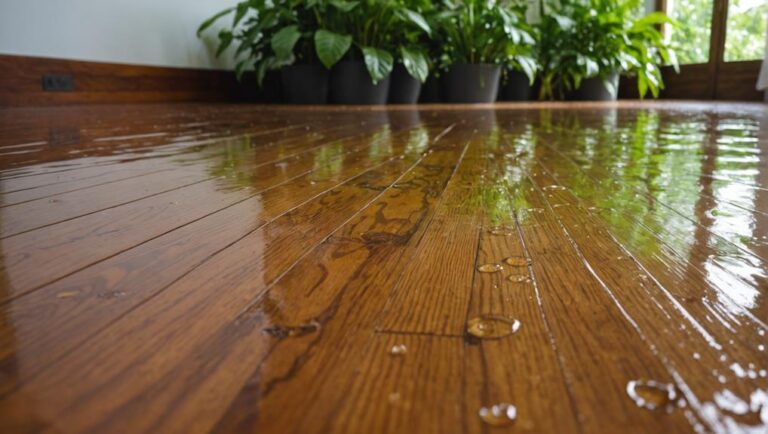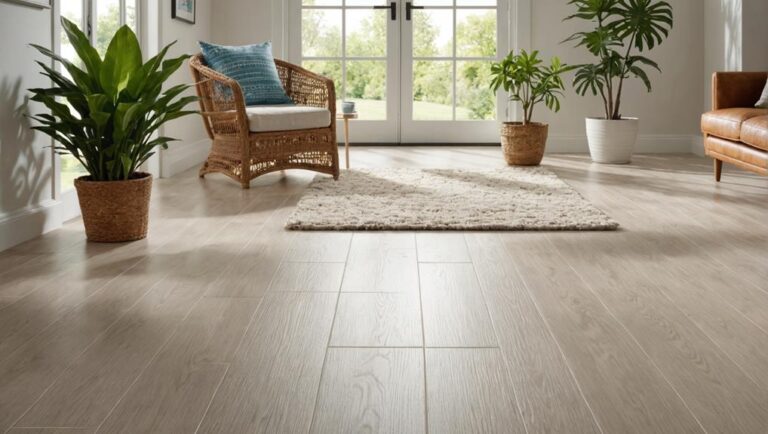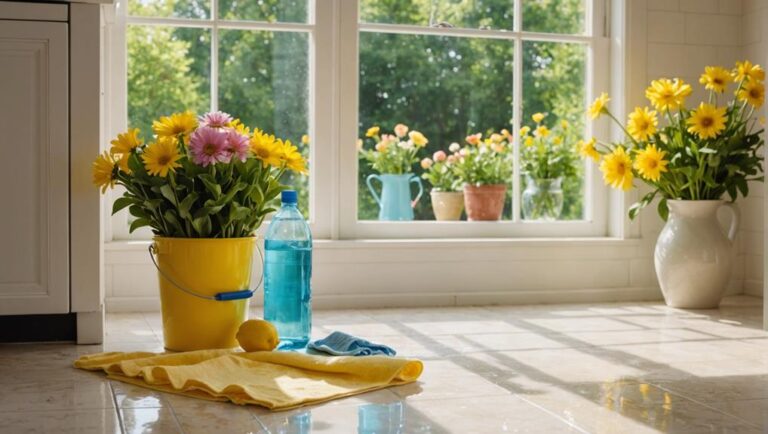When considering smart floor options for energy-efficient homes, you'll find various solutions that maximize comfort and minimize energy use. Radiant heating systems and smart thermostats allow for precise temperature control, reducing reliance on heating and cooling. Eco-friendly materials like recycled carpets and sustainable wood flooring not only enhance aesthetics but also promote a healthier indoor environment. Additionally, integrated smart home technologies can monitor energy consumption and optimize usage patterns. By opting for smart flooring, you're making a wise investment in both your home's value and the environment. Discover more on how these innovations can transform your living space.
Benefits of Smart Flooring
Smart flooring often plays an imperative role in enhancing energy efficiency within homes. By incorporating the latest smart flooring innovations, you can considerably reduce energy consumption while improving your home's overall comfort and safety. Smart flooring isn't just about aesthetics; it's about creating a functional environment that responds to your needs and promotes sustainability.
One of the key benefits of smart flooring is its ability to adapt to environmental changes. Many flooring technology trends include sensors that can detect temperature fluctuations and adjust accordingly. This means your flooring can help maintain a consistent temperature, reducing the reliance on heating and cooling systems, which is vital for energy savings. Additionally, these innovations often come with advanced insulation properties, keeping your home warm in winter and cool in summer.
Safety is also a priority with smart flooring. Many options feature slip-resistant surfaces and are made from materials that minimize the risk of injuries. You'll find that certain smart flooring systems can even alert you to potential hazards, like excessive moisture, which could lead to mold or structural damage. These safety features give you peace of mind, knowing that your flooring is working to protect your home and your family.
Incorporating smart flooring into your home not only aligns with modern flooring technology trends but also enhances energy efficiency, comfort, and safety. Investing in smart flooring is a step towards a sustainable and secure living environment, making it a wise choice for any homeowner.
Radiant Heating Systems
Radiant heating systems are an excellent complement to the energy-efficient benefits of smart flooring. By integrating a radiant floor system, you can greatly enhance your home's comfort while minimizing energy consumption. These systems use either electric cables or water-filled tubing to warm your floors, ensuring even heat distribution throughout the space. This method not only feels luxurious but also helps maintain a consistent temperature, reducing the need for traditional heating methods.
When considering installation techniques, it's essential to assess system compatibility with your chosen flooring materials. Not all flooring types work equally well with radiant heating. For instance, tile and stone conduct heat efficiently, while some carpets may insulate against it. Additionally, zoning systems allow you to customize temperature control in different areas of your home, optimizing energy use further.
Maintenance requirements for radiant heating systems are generally low, but regular checks can help prolong their lifespan. Understanding the initial cost analysis is important; while installation can be a considerable investment, the long-term energy savings often outweigh these costs. You're not just investing in comfort; you're making a choice that's safer and more sustainable for the environment.
Smart Thermostats and Sensors
How can integrating smart thermostats and sensors transform your energy management? By adopting these advanced technologies, you can gain precise control over your home's heating and cooling systems, leading to significant energy savings and enhanced comfort. With the right thermostat compatibility, you can guarantee your devices work seamlessly together, maximizing efficiency.
Here are four key benefits of smart thermostats and sensors:
- Automated Adjustments: Smart thermostats learn your schedule and preferences, adjusting temperatures automatically to reduce energy use when you're away.
- Remote Monitoring: Access your home's temperature settings remotely via smartphone apps, allowing you to make real-time adjustments for safety and comfort.
- Sensor Calibration: Accurate sensor calibration guarantees that your thermostat receives precise data about your home's conditions, preventing energy waste caused by incorrect readings.
- Energy Reports: Many smart thermostats provide detailed energy usage reports, helping you understand your consumption patterns and identify areas for improvement.
Integrating smart thermostats and sensors into your energy management strategy not only enhances comfort but also contributes to a safer home environment. By controlling your heating and cooling systems more effectively, you can reduce the risks associated with energy overconsumption and maintain a stable indoor climate. This proactive approach to energy efficiency can lead to lower utility bills while providing peace of mind, knowing that your home is being managed intelligently. Embrace the future of home energy management with smart technology today.
Energy-Efficient Carpet Options
When it comes to enhancing energy efficiency in your home, choosing the right carpet can make a considerable difference. You might not realize it, but the materials used in carpets greatly impact not just your home's energy consumption but also its overall safety and comfort. Opting for carpets made from recycled materials can considerably lower your carbon footprint. These recycled carpets often utilize post-consumer products, transforming waste into beautiful flooring without sacrificing quality.
Additionally, consider carpets made from natural fibers like wool, jute, or sisal. These materials are not only biodegradable but also provide excellent insulation, which helps maintain your home's temperature. This insulation can reduce your reliance on heating and cooling systems, further cutting down on energy costs. Plus, natural fibers are less likely to emit harmful chemicals compared to synthetic options, making them a safer choice for your family's health.
When selecting energy-efficient carpets, look for certifications that verify low VOC (volatile organic compounds) emissions. This guarantees that the carpet won't compromise your indoor air quality. Furthermore, investing in high-quality, durable carpets means you won't need to replace them as often, ultimately saving you money and resources in the long run.
Eco-Friendly Tile Solutions
When considering eco-friendly tile solutions, you'll want to focus on sustainable materials that not only reduce environmental impact but also enhance your home's aesthetic. Options like recycled glass or sustainably sourced ceramic can offer durability without compromising on style. Additionally, energy-efficient installation methods can further minimize your carbon footprint, making your flooring choice both smart and responsible.
Sustainable Material Choices
Choosing the right tile for your home can make a significant impact on both aesthetics and sustainability. When you opt for eco-friendly tile solutions, you're not just enhancing your space; you're also contributing to a healthier planet. Here are some sustainable material choices to take into account:
- Recycled Materials: Tiles made from recycled glass or ceramics reduce waste and lessen the demand for new resources.
- Bamboo Flooring: This rapidly renewable resource offers a unique look while being stronger than many hardwoods, making it a stylish and sustainable choice.
- Cork Alternatives: Cork is harvested from the bark of trees without harming them, providing a soft, water-resistant option that's also biodegradable.
- Low VOC Finishes: Choosing tiles with low volatile organic compounds guarantees better indoor air quality, making your home safer for your family.
With options like these, you can create a beautiful, sustainable environment. Plus, many of these materials come with water-resistant options that enhance durability. By focusing on sustainable sourcing, you're not only investing in your home's aesthetics but also in its long-term health and safety.
Energy-Efficient Installation Methods
An energy-efficient installation can greatly enhance the benefits of eco-friendly tile solutions in your home. By focusing on proper installation techniques, you can minimize energy loss and create a safer environment. Start with an energy audit to assess your home's current performance. This will help identify areas needing improvement and guide you in choosing the best tile options.
When selecting your installation methods, consider using adhesive materials with low VOC emissions to maintain indoor air quality. Additionally, guarantee that the substrate is level and clean, as this will promote better adhesion and reduce the risk of tiles cracking or shifting over time. Properly insulating floors can also prevent heat loss, making your home more energy-efficient.
You might also want to explore radiant heating systems beneath your eco-friendly tiles. Not only do they provide a cozy warmth, but they can also lead to significant energy savings by allowing you to lower your thermostat during colder months. Ultimately, prioritizing energy-efficient installation methods will enhance the performance of your eco-friendly tile solutions while guaranteeing a healthier space for you and your family.
Wireless Floor Heating Solutions
When considering efficient heating options, wireless floor heating systems offer a range of benefits, including enhanced comfort and energy savings. However, it's essential to weigh installation considerations and best practices to guarantee peak performance. By understanding these factors, you can make an informed decision that elevates your home's energy efficiency.
Benefits of Wireless Heating
Wireless heating solutions, particularly in the domain of floor heating, offer a modern approach to comfort and energy efficiency in your home. By embracing wireless technology, you can enjoy enhanced convenience and significant energy savings. Here are some key benefits of wireless heating systems:
- Energy Efficiency: Wireless floor heating allows for precise temperature control, ensuring you only use energy when and where it's needed, leading to lower utility bills.
- Easy Installation: Without the need for extensive wiring, these systems can be installed quickly and with minimal disruption to your living space.
- Improved Comfort: Radiant heat warms your floors and the air above, creating a cozy environment that's particularly beneficial during colder months.
- Smart Control: Many wireless systems offer smart home integration, allowing you to adjust settings remotely, ensuring your home is always at your desired temperature.
Installation Considerations and Tips
Installing wireless floor heating can transform your living space, but careful planning is vital to guarantee a successful setup. First and foremost, focus on subfloor preparation. Confirm your subfloor is clean, dry, and level, as this will affect the performance of your heating system.
Next, prioritize moisture control. It's essential to address any potential moisture issues before installation. A vapor barrier can be an effective solution, especially in areas prone to dampness.
Here's a quick reference to bear in mind during installation:
| Consideration | Tip |
|---|---|
| Subfloor Preparation | Clean, dry, and level the surface. |
| Moisture Control | Install a vapor barrier if necessary. |
| System Layout | Plan wire placement for best coverage. |
Following these guidelines will not only enhance the efficiency of your wireless floor heating but also contribute to a safer environment. A proper setup minimizes risks associated with moisture and uneven heating, allowing you to enjoy the comfort of your new flooring without worry. Always consult with professionals if you're uncertain about specific installation procedures.
Foot Traffic Monitoring Tiles
Foot traffic monitoring tiles are revolutionizing how homeowners manage energy consumption and space utilization. By integrating advanced sensor technology, these tiles track movement patterns in your home, allowing you to make informed decisions about your energy use and layout. This innovative approach isn't just about convenience—it's also about safety and efficiency.
Here are four key benefits of foot traffic monitoring tiles:
- Energy Efficiency: By analyzing data from foot traffic patterns, you can identify areas of your home that need more or less heating or cooling, optimizing your energy consumption.
- Space Utilization: Understanding foot traffic helps you reorganize furniture or spaces for better flow, making your home safer and more comfortable to navigate.
- Real-Time Data Analytics: These tiles provide real-time insights into household activity, enabling you to respond quickly to unusual patterns that could indicate safety concerns, such as falls or intrusions.
- Enhanced Security: With the ability to monitor foot traffic, you can set alerts for unexpected movement during off-hours, enhancing the security of your home.
Incorporating foot traffic monitoring tiles into your home isn't just a smart investment; it's a step toward a safer, more efficient living environment. By leveraging sensor technology and data analytics, you'll gain a clearer understanding of your household dynamics, ultimately leading to a more energy-efficient and secure home.
Sustainable Wood Flooring
Sustainability is becoming increasingly important in our choices for home materials, and sustainable wood flooring presents an attractive option for eco-conscious homeowners. By opting for wood flooring sourced from responsibly managed forests, you're not just enhancing your home's aesthetic; you're also making a commitment to the environment. Eco-friendly sourcing guarantees that the wood you choose supports sustainable forestry practices, which help preserve biodiversity and reduce carbon emissions.
One of the most compelling options is reclaimed wood. This unique flooring material is sourced from old barns, factories, and other structures, giving it a rich history and character. By repurposing wood that's already been harvested, you're reducing the demand for new timber and minimizing waste. Plus, reclaimed wood often boasts superior quality and durability, making it a smart long-term investment for your home.
When selecting sustainable wood flooring, look for certifications like the Forest Stewardship Council (FSC) label. This guarantees the wood meets strict environmental and social standards, giving you peace of mind about the safety and sustainability of your choice. You'll also want to take into account finishes and adhesives that are low in volatile organic compounds (VOCs), which can negatively impact indoor air quality.
Incorporating sustainable wood flooring in your home not only elevates its design but also aligns with a broader commitment to protecting our planet. It's a decision that reflects your values and contributes to a healthier living environment for you and your family.
Smart Home Integration
As you invest in sustainable wood flooring to enhance both your home's aesthetics and environmental impact, reflect on how smart home integration can further elevate your living experience. By seamlessly combining your eco-friendly flooring with smart technology, you can create a safer, more efficient home environment that meets modern demands.
Here are four key aspects to reflect on for effective smart home integration:
- Smart Lighting Integration: Automated lighting systems allow you to control brightness and color temperature, optimizing energy use and enhancing comfort. You can set schedules or use motion sensors to guarantee lights are off when rooms are unoccupied, contributing to energy savings.
- Automated Window Treatments: These treatments can adjust based on the time of day or temperature, helping regulate indoor climate and reducing energy consumption. They can block excessive sunlight during peak hours, keeping your home cooler without over-relying on air conditioning.
- Home Security Systems: Integration with smart locks and cameras provides peace of mind, allowing you to monitor your home from anywhere. You can receive alerts and even control access remotely, ensuring your home remains a safe haven.
- Energy Monitoring Tools: These devices track your home's energy consumption in real time, empowering you to make informed adjustments. By identifying patterns, you can take actionable steps to reduce waste and improve efficiency.
Cost Considerations and Savings
When considering smart flooring options, it's essential to evaluate not just the upfront costs but also the long-term savings they can provide. Many smart flooring solutions, such as radiant heating systems or energy-efficient materials, may have a higher initial price tag. However, these investments can yield significant cost savings over time by reducing energy consumption and enhancing overall home efficiency.
Incorporating smart flooring into your home can lead to lower utility bills as these systems are designed to optimize energy use. For example, heated floors can maintain warmth more efficiently than traditional heating methods, which means you won't have to crank up your thermostat as often. This not only saves money but also contributes to a safer, more comfortable living environment.
As you engage in budget planning, consider the potential return on investment that smart flooring can offer. While the upfront costs might seem intimidating, weigh them against the long-term benefits. Additionally, many smart flooring options come with warranties and maintenance plans, reducing unexpected expenses that could arise later.
Ultimately, choosing the right smart flooring can provide peace of mind through enhanced safety and energy efficiency. By carefully evaluating your options and factoring in cost savings over the lifespan of the flooring, you can make an informed decision that aligns with your budget and lifestyle. Investing in smart flooring not only enhances your home's value but also contributes to a sustainable future.
Frequently Asked Questions
How Do Smart Floors Impact Indoor Air Quality?
Smart floors can greatly impact indoor air quality by enhancing air circulation and enabling better temperature control. When you've got floors that adjust to your home's climate, it helps prevent moisture buildup, which can lead to mold and allergens. Better air circulation means fewer pollutants linger in the air, promoting a healthier environment. If you're mindful of air quality, investing in smart flooring can be a worthwhile choice for your well-being.
Can I Retrofit Existing Floors With Smart Technology?
Yes, you can retrofit existing floors with smart technology. Retrofitting offers benefits like improved energy efficiency and enhanced comfort. However, you should consider potential installation challenges, such as the need for specialized tools or expertise. It's essential to guarantee safety during the installation process, as improper handling can lead to hazards. By weighing these factors, you can make a well-informed decision that enhances your home's functionality while maintaining a safe environment for everyone.
What Maintenance Is Required for Smart Flooring Systems?
When it comes to smart flooring systems, maintenance is key for longevity and efficiency. You'll need to regularly clean the smart floor materials to guarantee sensors and technology function properly. Inspect the smart floor installation periodically for any signs of wear or damage. If issues arise, addressing them promptly can prevent larger problems. Staying proactive with maintenance not only keeps your floors safe but also maximizes the benefits of your investment in smart technology.
Are Smart Floors Compatible With All Types of Furniture?
You might think that smart floors aren't compatible with all types of furniture, but that's not the case. Most smart flooring systems can handle various furniture weights, provided you choose the right materials. However, always check the specifications to ascertain compatibility, especially for heavier pieces. Floor sensors are designed to work seamlessly under furniture, enhancing safety and functionality without compromising your home's aesthetic. So, you can confidently furnish your space without concerns.
How Do Smart Floors Handle Moisture and Humidity Levels?
When considering how smart floors handle moisture and humidity levels, it is crucial to understand their built-in moisture sensors. These sensors actively monitor the environment, providing real-time data. If humidity levels rise beyond set thresholds, the system can trigger humidity control measures, helping to prevent issues like mold growth and damage. By investing in smart flooring, you're not just enhancing aesthetics; you're ensuring a safer, healthier living space by effectively managing moisture levels.




